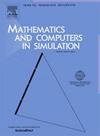Phase field-lattice Boltzmann model for axisymmetric two-phase ferrofluid flows
IF 4.4
2区 数学
Q1 COMPUTER SCIENCE, INTERDISCIPLINARY APPLICATIONS
引用次数: 0
Abstract
In this paper, a phase field-based lattice Boltzmann model is developed to simulate axisymmetric two-phase ferrofluid flows. The three-population multi-relaxation time lattice Boltzmann models are constructed to solve the conservative Allen-Cahn phase field equation, the velocity-based Navier-Stokes equations, and the magnetic scalar potential equation. To deal with axisymmetric effects, some appropriate equilibrium distribution functions and discrete source/forcing terms are given. The Chapman-Enskog analysis is used to show the consistencies between the present newly proposed multi-relaxation time flow field lattice Boltzmann model and macroscopic governing equations. In the numerical validation section, the Laplace law and a sphere in a uniform magnetic field were simulated, which the simulation results show good agreement with the analytical solutions. Then several typical problems such as ferrofluid droplet deformation, Rayleigh–Plateau instability, two bubbles merging and bubble rising in ferrofluids are numerically studied to explore the mechanism of phase field interface dynamics in two-phase ferrofluid flows. As the density ratio between the two phases ranges from 1.975 to 1000, and the dynamic viscosity ratio ranges from 1 to 200, the numerical simulation results are satisfactory. This indicates that the proposed model can effectively deal with complex two-phase ferrofluid flows with large density and viscosity ratios.
轴对称两相铁磁流体流动的相场晶格玻尔兹曼模型
本文建立了一种基于相场的晶格玻尔兹曼模型来模拟轴对称两相铁磁流体的流动。建立了三种群多弛豫时间晶格Boltzmann模型,求解了保守的Allen-Cahn相场方程、基于速度的Navier-Stokes方程和磁标量势方程。为了处理轴对称效应,给出了适当的平衡分布函数和离散源/强迫项。Chapman-Enskog分析显示了新提出的多松弛时间流场晶格玻尔兹曼模型与宏观控制方程之间的一致性。在数值验证部分,对均匀磁场中的拉普拉斯定律和球面进行了模拟,模拟结果与解析解吻合较好。然后对铁磁流体中液滴变形、瑞利-高原不稳定、两泡合并和气泡上升等典型问题进行了数值研究,探讨了两相铁磁流体流动相场界面动力学的机理。当两相密度比为1.975 ~ 1000,动黏度比为1 ~ 200时,数值模拟结果令人满意。这表明该模型可以有效地处理大密度、大粘度比的复杂两相铁磁流体流动。
本文章由计算机程序翻译,如有差异,请以英文原文为准。
求助全文
约1分钟内获得全文
求助全文
来源期刊

Mathematics and Computers in Simulation
数学-计算机:跨学科应用
CiteScore
8.90
自引率
4.30%
发文量
335
审稿时长
54 days
期刊介绍:
The aim of the journal is to provide an international forum for the dissemination of up-to-date information in the fields of the mathematics and computers, in particular (but not exclusively) as they apply to the dynamics of systems, their simulation and scientific computation in general. Published material ranges from short, concise research papers to more general tutorial articles.
Mathematics and Computers in Simulation, published monthly, is the official organ of IMACS, the International Association for Mathematics and Computers in Simulation (Formerly AICA). This Association, founded in 1955 and legally incorporated in 1956 is a member of FIACC (the Five International Associations Coordinating Committee), together with IFIP, IFAV, IFORS and IMEKO.
Topics covered by the journal include mathematical tools in:
•The foundations of systems modelling
•Numerical analysis and the development of algorithms for simulation
They also include considerations about computer hardware for simulation and about special software and compilers.
The journal also publishes articles concerned with specific applications of modelling and simulation in science and engineering, with relevant applied mathematics, the general philosophy of systems simulation, and their impact on disciplinary and interdisciplinary research.
The journal includes a Book Review section -- and a "News on IMACS" section that contains a Calendar of future Conferences/Events and other information about the Association.
 求助内容:
求助内容: 应助结果提醒方式:
应助结果提醒方式:


